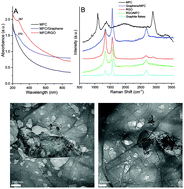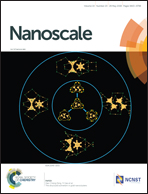Co-exfoliation and fabrication of graphene based microfibrillated cellulose composites – mechanical and thermal stability and functional conductive properties†
Abstract
The excellent functional properties of graphene and micro-nanofibrillated cellulose (MNFC) offer plenty of possibilities for wide ranging applications in combination as a composite material. In this study, flexible graphene/microfibrillated cellulose (MFC) composite films were prepared by a simple method of co-exfoliation of graphite in an MFC suspension by high-shear exfoliation. We show that pristine graphene, without any chemical treatment, was homogeneously dispersed in the MFC matrix, and the produced composites showed enhanced thermal, electrical and mechanical properties compared to a non-co-exfoliated control. The film properties were studied by XPS, XRD, Raman, SEM, FTIR, TGA, nitrogen sorption, UV-vis spectroscopy, optical and formation analysis tests. At 0.5 wt% loading, the specific surface area of graphene/MFC composites increased from 218 to 273 m2 g−1 while the tensile strength and Young's modulus for the graphene/MFC composites increased by 33% and 28% respectively. Thermal stability was enhanced by 22% at 9 wt% loading and the composites showed a high electrical conductivity of 2.4 S m−1. This simple method for the fabrication of graphene/MFC composites with enhanced controlled functional properties can prove to be industrially beneficial, and is expected to open up a new route for novel potential applications of materials based largely on renewable resources.



 Please wait while we load your content...
Please wait while we load your content...